Chris Riley's last ride
The grandfather of Austin's urbanist movement rides into the sunset.

Please feel free to share this story with anyone who has known Chris Riley or would appreciate understanding his profound influence on the city.
Chris Riley has one major concern and it’s not his impending death.
Riley, 59, was diagnosed with Stage 4 cancer last year, after an x-ray and CT scan following a bike crash revealed lesions on his liver and lymph nodes. He is surprised that he's made it this far. At this point, the physical toll of the disease sometimes makes him feel like he has "one foot in the grave."
He’s not scared of dying.
“I was some time ago,” he told me on the phone last week. “And now I’m not. I don’t know what changed. I feel very much at peace with dying.”
He described feeling a profound sense of relief when his doctors told him recently that he had exhausted his treatment options and likely only had a few months left. He likened it to a psychedelic experience.
“Ever since then I’ve been kind of in that mode –– wanting to hug everybody. It’s just filled me with love and gratitude. I feel like I’m overflowing with gratitude.”
He has a lot to be grateful for, starting with his partner of 25 years, Denise, who he finally married last September in a ceremony officiated by their old friend Lloyd Doggett.
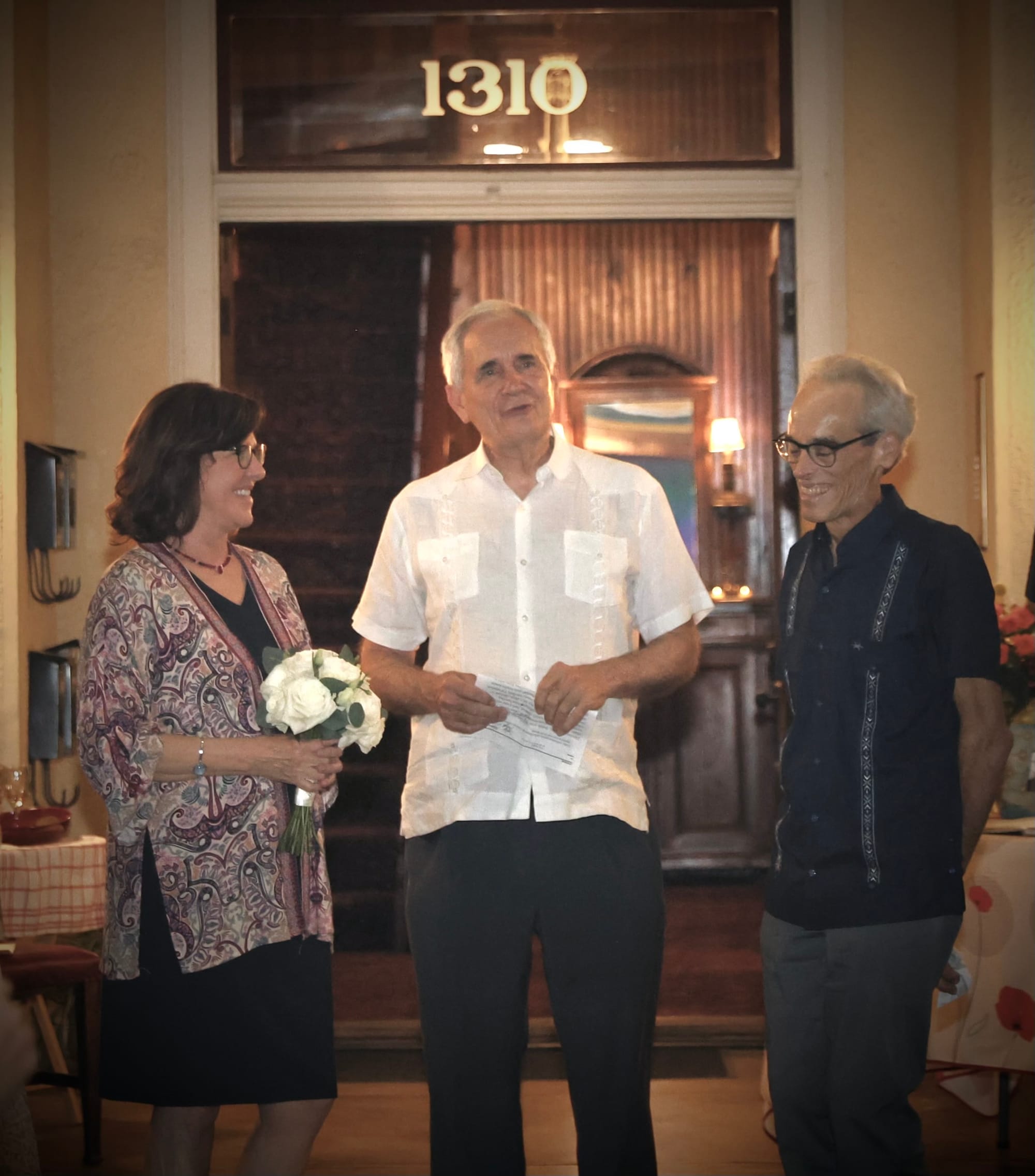
He’s also tremendously grateful that in the past year he’s been able to witness the Austin urbanist movement achieve victories that only a few years ago seemed impossible. Given the doom and gloom of national news coverage in recent days, it may seem surprising that a lifelong Democrat feels good about the state of the world, but the young people who have pushed Austin to become a greener, more “welcoming city” fill Riley with optimism.
He cites the elimination of parking requirements, the passage of a variety of pro-housing code reforms and the steps the city has taken toward improving pedestrian and bike infrastructure.
“I look forward to resting in peace,” he said. “That idea does not scare me. And it’s largely because in terms of the issues I care a lot about, I feel like we’re in pretty good hands.”
Two last hurrahs
Riley is hosting two parties at his downtown home at 1310 San Antonio St. this week. Everyone is invited.
The first, on July 10, at 5:30 pm, will be an urbanist happy hour open to anybody who wants to celebrate the movement’s recent accomplishments.
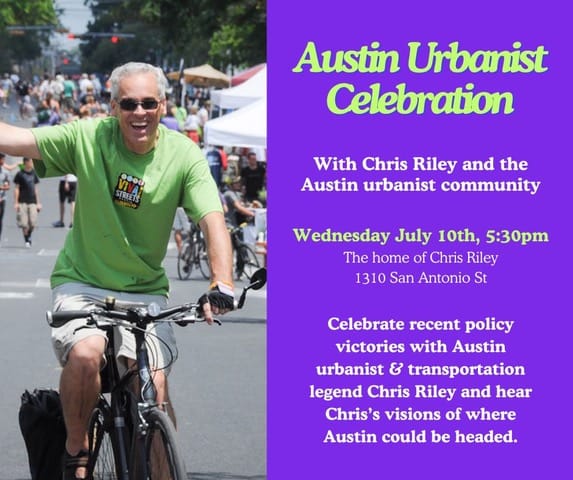
The second party on July 12, his 60th birthday, will start at 4 p.m. and will be non-political. He wants it known that absolutely everybody is welcome; he is eager to reconnect with old friends, colleagues or anyone else who wishes to see him.
He is also hoping to keep alive the weekly Giant Chess game that he has for years led in Wooldridge Park downtown. If you’re interested, it will be happening this Saturday from 12-3 p.m., organized by longtime City Hall aide Michael McGill, who never worked for Riley but considers him an important mentor.
Building a legacy
Amidst all of the happiness, Riley still has one nagging concern: He wants to complete, or at least make substantial progress on, the renovation of the cottage that sits next-door to his home on San Antonio St. Both his own 130-year-old house and the cottage were originally occupied by the same family, but eventually ownership of both structures changed hands and the cottage, like so many old downtown homes, became a law office. Riley has always viewed the cottage as a “little sister” to his house, and jumped at the opportunity to buy it after a fire ravaged it a few years ago.

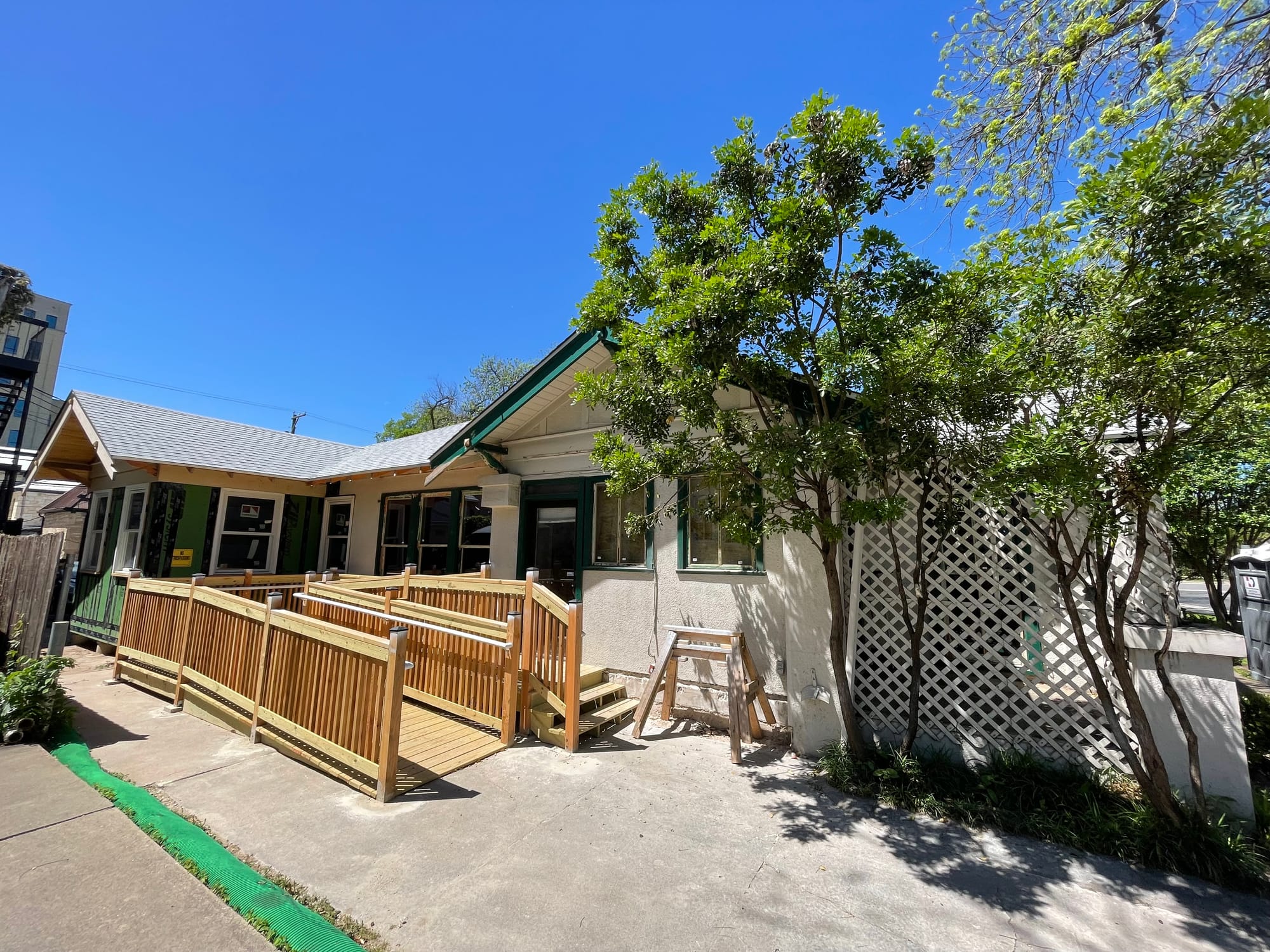
He wants to make sure he can get the work done so that he doesn’t leave Denise “with a mess that she has to deal with.”
It’s been quite the mess, courtesy largely of Austin’s byzantine permitting process. He’s been accruing $400 fines every week for the past four years for a variety of code violations: holes in the roof, the lack of a functioning electrical system, the broken windows. He believes he will eventually be able to get the more than $80,000 in fines dismissed, but it's a fitting example of how the city code conflicts with seemingly all of the city's stated goals, whether it's sustainability, affordability or historic preservation.
“For a long time the code department was urging me to tear the building down– which would have been a much quicker way of resolving the code violations, but I don’t believe that would’ve been a good outcome for the neighborhood,” he said. “The bungalow is a contributing structure in what is now a national register historic district, and throughout this process my neighbors have been supportive of keeping the building in place.”
Riley initially aspired to turn the home into a three-story sixplex. That was allowable under city code, but he couldn't get the financing for it. So his next thought was something more modest: perhaps a two-unit home? Alas, the same code that would allow a six-unit multifamily development would not allow a two-unit residential development because, even after the recent HOME initiative, the 3,300 square foot lot is too small for more than one unit.
However, for whatever reason, the code will allow him to develop it into a two-unit hotel, which is what he’s trying to do, although he hopes that someday it will be allowed to become housing.
At this point, the permitting process is largely behind him, but there is still plenty of work dealing with sub-contractors and the like.
Fortunately, the city couldn’t stop him from turning the second floor of his own house into two rental units, where he has been delighted to welcome tenants.
"This is a more appealing place to walk around," than other parts of the central business district, he said. "The beautiful old houses and the nice tree canopy. I want to do everything I can to add more homes and maintain those features of the area that make it so inviting."
And yet, in keeping with his political views, Riley has never sought to have his undeniably historic home designated a historic landmark.
"It just seems presumptuous for me to dictate for all future generations what the use of this land should be," he said. "I can imagine at some point the need for housing outweighs the need for this house here."
A downtown pioneer
Embracing change has been the central feature of Riley’s three-and-a-half decades of public service. It began with his advocacy for his own neighborhood, which he always wanted to share with more people, whether they live in bucolic old houses or in one the many glimmering towers that now dot the rapidly expanding skyline.
When the Tarrytown-raised Riley moved downtown in 1990, the neighborhood was nearing the end of a half-century of steady population decline that had occurred even as Austin's total population had quintupled.
He had scored an apartment at 7th & Nueces, a short walk from his job at the Texas Supreme Court. Austin at the time was cheap, but downtown was particularly cheap because seemingly nobody wanted to live there anymore.
He wondered why so few others were joining him in enjoying the pleasures of downtown living. The magnificent old houses still stood, but they ceased to be homes, instead becoming law offices or accounting firms.
"I was looking around and noticing that something had gone strangely wrong in this neighborhood," he said. "There had been a lot of people living here at one time but [by] then, not so many. Most of the residential population downtown was registered at either the Salvation Army or the jail."
He remembered asking the legendary environmental activist, Shudde Fath, why everybody had moved out of downtown. The subdivisions being built around the urban core felt like the future, he recalled her saying. “It seemed like the future was, ‘you move out, nobody wants to be down here anymore.’”
It didn’t make sense to him. Why did we give up on such a good thing?
“I have pondered why I am such a polar opposite of everyone I grew up with in Tarrytown,” he said. “I think it has to do with having experienced urban life as a very young guy in DC and then four years in Boston for college.”
Well, “outside of Boston” to be precise, but even Cambridge, where Riley attended Harvard, is six times denser than Austin. And when other Tarrytown teenagers were making good use of their newly-acquired drivers licenses, Riley was living a car-free existence on Capitol Hill in Washington D.C., where he served as a congressional page for much of his junior and senior years of high school.
It’s not that he hated driving. In fact, after law school he went to great lengths to find a car he loved: a red 1963 Buick Skylark convertible. He liked that it allowed him to interact with the rest of the world in a way a closed-roof car wouldn’t and enjoyed the smiles it brought to the faces of passers-by.
The Skylark, however, was constantly in need of repairs. Eventually, at some point in the 2000’s, after many years of being “car-light,” he decided to go car-less and has never looked back. “I felt so liberated,” he said.
A new kind of neighborhood advocacy
In 1997 Riley co-founded the Downtown Austin Neighborhood Association, a group that for the first 20 years of its existence was part of the Austin Neighborhoods Council, the neighborhood federation best known for its dogmatic defense of low-density, suburban character.
DANA was a conspicuous ideological outlier in ANC. While most of the other groups sought to limit the population of their neighborhoods, DANA wanted more people to move in.
"I felt like an awful lot of neighborhoods were saying 'no' to housing," Riley recalls. "And I looked around my own neighborhood and thought, we could use some of that here."
He had also been reading a lot about the policy decisions that had in his view sacrificed the best qualities of urban living. Jane Jacobs’ The Death and Life of Great American Cities and James Howard Kunstler’s The Geography of Nowhere were particularly influential.
Riley had a very different perspective on urban planning than most of his ANC peers, but he thoroughly enjoyed attending ANC meetings and bonding with fellow neighborhood activists: “Even when there was no chance in hell of them supporting me, I just loved going to those things.”
Both sides got some of what they wanted. The other neighborhoods have largely succeeded in maintaining a low-density, single-family character, while downtown has utterly transformed and now counts more than 15,000 residents. Those contrasting trends were part of a larger compromise championed by Mayor Kirk Watson in the late 90’s between environmentalists, the business community and neighborhood associations.
“Neighborhood planning first emerged as Kirk Watson’s way of getting additional density in the city in a way that would be amenable to neighborhood [associations],” Riley recalled. “He would first propose something citywide and [Council Member] Laura Morrison would say no, you have to respect neighborhood context. It was an awful lot of work that resulted in very complicated zoning maps and not much housing to show for it.”
Although urbanists are often perceived as subservient to the wishes of the real estate industry, in many cases Riley wanted the city to demand better products from downtown developers. He was incensed when the Planning Commission allowed a new condo tower on Rainey Street to devote its ground floor to a parking garage instead of retail, as typically required. Some were sympathetic to the developer’s claim that retail wasn’t feasible in that location while the chair of the commission, legendary preservationist Betty Baker, said it didn’t make sense to have business in a residential neighborhood.
The idea that Austin’s booming growth would give people downtown nothing to walk to but parking garages horrified Riley.
“I was just so mad,” he recalled. “I raised a big fuss. That sort of thing was just pissing me off so much. I didn’t even have the right vocabulary for it, I just knew it was wrong.”
It was a recurring theme at the time: developers saw ground-floor retail as a “nuisance,” rather than an opportunity. Fortunately, that has since changed –– at least downtown.
Eventually Riley got himself appointed to the Planning Commission by Council Member (and later Mayor) Will Wynn, a former chair of the Downtown Austin Alliance who appreciated his downtown advocacy. Most of the members generally embraced an “urbanist perspective” but its recommendations were often ignored by City Council. Though plenty of Council members understood the value of new development, they were also wary of upsetting change-averse constituents.
“The whole atmosphere was so hostile to development that nobody could think straight about the actual merits, about whether the urban environment would be better or worse than today,” he said.
He recalled, for instance, the debate over the Spring Condos, one of the first major residential towers downtown. Betty Baker, the Planning Commission chair, likened it to a "giant middle finger" to surrounding neighborhoods, while other residents of Tarrytown and Clarksville raised scientifically dubious claims that the 42-story building would create "wind tunnels" that would render neighborhoods miles to the west unbearable. Two decades later, the property values of both neighborhoods suggest that nothing of the sort occurred.
Council Member Riley
Riley served seven years on the Planning Commission (2001-08) before jumping at the chance to run for the Council seat that Lee Leffingwell had vacated when he was elected mayor.
“I was right on the heels of Obama,” he said. “There were all these young people who had just gotten involved and were fired up about change.”
In a recent conversation, Riley couldn’t recall what the “perceived policy differences” were between him and his opponent, Perla Cavazos. He remembered highlighting his neighborhood advocacy and deep roots in Austin. The battle between environmentalists and developers that had dominated the 90’s had subsided, and the housing crisis that prompted the NIMBY-YIMBY battles of the second half of the 2010’s had not yet arrived.
“It seems like such an innocent era now. Things have gotten so nasty since then. At every level. That was before Twitter and it was just a different time,” he recalled.
Certain parts of campaigning didn’t come naturally to Riley, whose geeky demeanor is endearing to those who know him but not ideal for an elevator pitch. He particularly hated “call time” –– the period of each day devoted to asking people for money.
“It was just awful. Imagine spending two hours everyday doing that,” he said.
And yet, he was elected, and for that he was thrilled. His first day on the job was one of the most exciting of his life. That he would get paid to put his ideals into action was almost too good to be true. He calls his time on Council the greatest experience of his life.
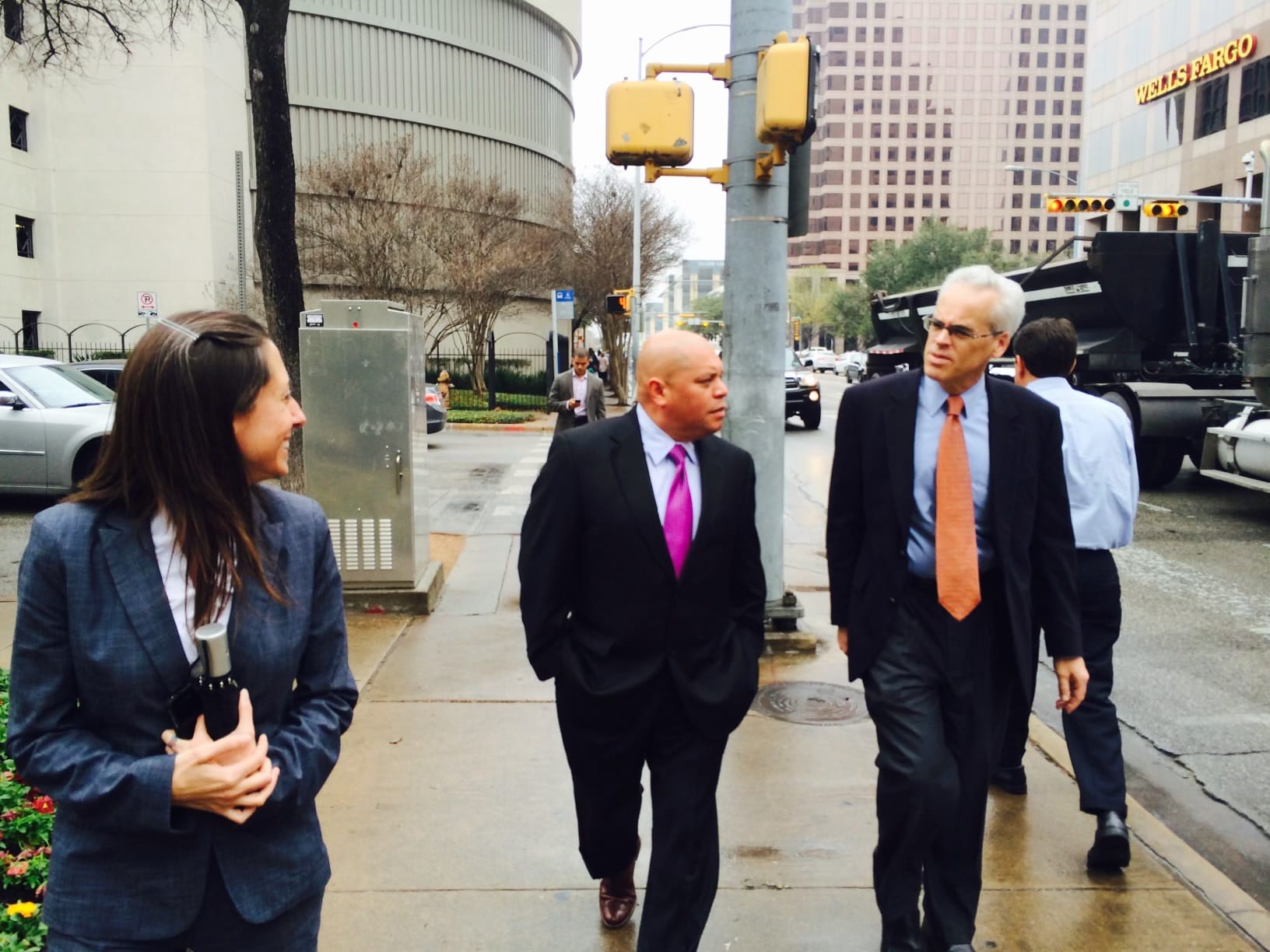
Like most politicians, his tenure in elected office came with highs and lows. The accomplishments he is proudest of sound niche but in fact have a profound effect on how people in Austin experience their city.
For starters, getting the city to adopt the National Association of City Transportation Officials (NACTO) street design standards, which allowed city transportation planners to place a greater emphasis on the pedestrian and cycling experience than the car-centric standards under which the city had previously operated.
The move to NACTO standards fed into another one of Riley’s policy triumphs: the 2014 Bicycle Master Plan. For the first time ever, the city of Austin embraced the concept of protected bike lanes. A decade later protected lanes are common, although still not nearly as common as they should be and often not nearly as “protected” as they should be. Biking is not as safe and pleasant as one would hope, but it has undoubtedly gotten better in no small part due to Riley’s efforts.

Second on Riley’s big win list is the elimination of parking requirements downtown. Although the item ultimately passed easily, the fight to get to a vote was long and hard. Tarrytowners worried that their own streets would be crammed with the parked cars of downtown revelers if the rapidly-growing number of office buildings, restaurants, bars, and condo towers weren’t required to dedicate a certain amount of asphalt to housing automobiles.
More than a decade later, glimmering office buildings with as many as 16 floors of car stalls are proof that the elimination of parking requirements does not mean the elimination of parking. What it does mean is less parking –– and therefore more space that can be devoted to more productive and interesting things: homes, businesses, patios, gardens. And it established a crucial precedent for City Council when it voted to make Austin the first major U.S. city to do away with parking requirements entirely.
The third accomplishment that Riley highlights: accessory dwelling units, sometimes known as granny flats. Towards the end of his tenure, he initiated a code amendment that made it legal to build ADUs on far more single-family lots than before. It wasn’t until he had left city government that Council actually codified the changes that he had kickstarted the previous year.
In between the broad policy wins were countless zoning cases. Riley was hardly the only one who understood that nothing good would come from blocking new housing, but he was the only one connecting the dots between Austin’s budding housing crisis and its residents’ dependence on carbon-belching cars.
“He made every developer think about bike/ped/transit because he always asked those questions,” recalled Leah Bojo, who served as his policy director for four years.
Riley had his share of disappointments on Council, some about which he can now laugh, and others that remain painful.
His greatest regret by far is his vote against a $750,000 settlement for the family of Nathaniel Sanders, an 18-year-old man who was fatally shot by an APD officer in the backseat of a car parked by an apartment complex in East Austin. Another man in the backseat, Sir Lawrence Smith, was also shot but survived. As is often the case in police shootings, the facts of the incident were vigorously disputed.
Looking back, Riley believes that what the officer did was “wrong on its face,” but the police association was putting tremendous pressure on Council to reject the settlement, and the pressure intensified after Sanders attorney Adam Loewy publicly suggested that approving the settlement amounted to an admission by the city that the shooting was unjustified. The politics of the times were different –– this was a few years before Michael Brown’s killing kicked off the Black Lives Matter movement. And the police had two staunch allies on the dais in Mayor Lee Leffingwell and CM Mike Martinez.
When the settlement came up for a vote, Riley spoke of the need for “reconciliation” and proposed lowering the amount to $500,000, saying that it would bring an “end that recognizes the legitimate concerns of both sides.”
That day, Council did not approve either settlement figure. Riley said he knew very shortly afterward that he had made the wrong decision. He recalled that Laura Morrison, with whom he so frequently clashed on other issues, had made the right call.
“I was so envious of Laura Morrison,” he said. “She didn't have any doubt about that.”
Fortunately, the $750,000 settlement came up again a year later and that time Riley joined the majority in approving it. But the regret he felt for the initial vote lingered nevertheless. He called it the “greatest mistake” of his life.
“My heart was there but my head wasn't,” he said. “It was shortly after the vote that my heart caught up to my head.”
Another regret: mentioning in a casual conversation with activist Brian Rodgers that Council members regularly discussed legislation outside of meetings. It had long been the practice for Council members to have weekly one-on-one meetings with each of their six colleagues (Council was smaller then) to discuss items on the next Council agenda. Riley didn’t think he was letting Rodgers in on a big secret.
Rodgers, however, relayed what Riley told him to the county attorney, who opened up a two-year investigation that resulted in the release of many embarrassing text and email exchanges and, eventually, every Council member entering into a “deferred prosecution” agreement for violations of open meetings law. Ever since then, Council has operated under a very strict (and contested) interpretation of state law in which members only talk about a given issue with members of their “sub-quorum” –– typically a group of four or five. It’s a win for transparency, but plenty of Council members, staffers and advocates say it makes thoughtful policymaking much harder.
“I made the mistake of having coffee with Brian Rodgers and trusting him more than I should have,” Riley said.
Riley was also disappointed by the evolution of Mayor Lee Leffingwell, whose election was initially heralded as a win for environmentalists but who grew steadily more conservative throughout his tenure. Riley was flabbergasted when Leffingwell sided with suburban conservatives on the CAMPO board in stripping any mention of climate change from the organization’s transportation plan.
“When you look at where he wound up compared to where he started, it kind of makes you scared of getting older,” said Riley, chuckling.
Happy in defeat
At the beginning of 2014, spending four years on the at-large City Council, Riley wasn’t planning on extending his Council career into the new era of geographic districts. And even after he announced that he would challenge his colleague Kathie Tovo in the race for the newly-created District 9, he didn’t expect to win.
“At the time, I found it hard to be popular,” he said. “Every zoning case the bulk of my emails were people saying, "Move to Dallas, you scum."
He said he was prompted to run when Tovo appointed the doggedly anti-density neighborhood activist Jeff Jack to the Code Advisory Group, a key player of the infamous eight-year CodeNEXT saga.
“Of all people, Kathie chose to put Jeff Jack on there,” he said. “And I felt like, ‘Oh, come on.’
I felt like I didn’t have a choice. I felt like you can’t just let that go uncontested.”
Tovo had also voted against Riley’s ADU measure, saying the issue should be left up to individual neighborhoods. These days a position like that would be viewed as hopelessly reactionary, but a decade ago it was pretty mainstream.
In a three-way race, Riley got 40% and Tovo got 49%. Riley was entitled to a runoff but opted to graciously concede the election. Tovo was similarly gracious in victory, applauding her opponent’s service.
The loss, which he had expected, did not greatly distress him. And luckily for Riley, the dozen years he had spent as a personal injury attorney before Council had been very kind to him financially. He was not under much pressure to earn.
So, he took a long trip through Europe, savoring the ancient wisdom of walkable urbanism. The following year he moved to Brooklyn, living alone (Denise visited frequently) while getting a master’s degree in urban placemaking and management at Pratt. Although his home was undeniably in Austin, he had always wanted to spend some time in New York, a city that he in many ways idolized. America’s largest city was a shining example of resistance to car culture.
“I’m so glad I crossed that off my bucket list,” he said.
Since then he has thrown himself into advocacy with a variety of groups. For a while he led Bike Austin, and he was thrilled to play a role in its merging with two other groups to form Safe Streets ATX, which advocates for prioritizing the safe movement of people over the rapid movement of cars. He also did another stint as president of the Downtown Austin Neighborhood Association.
Above all else, he has remained a consistent outside agitator for the things he believes in, usually in the background, rarely in search of the spotlight. In March, for instance, he sent me a lengthy email listing the qualities that Council should be looking for in a new city manager. He argued that Council should not settle for a competent bureaucrat, but should strive for a bold leader who shares its goals and will push the bureaucracy to achieve them. For instance, Riley said, city streets could really use more trees to reduce heat island effect, but a seemingly simple tree-planting initiative runs into a buzzsaw of departmental silos, regulatory barriers and general inertia.
In May, however, Riley was in the spotlight when City Council approved an ordinance, sponsored by CM Ryan Alter, to name a section of the Shoal Creek Trail after one of its greatest champions.
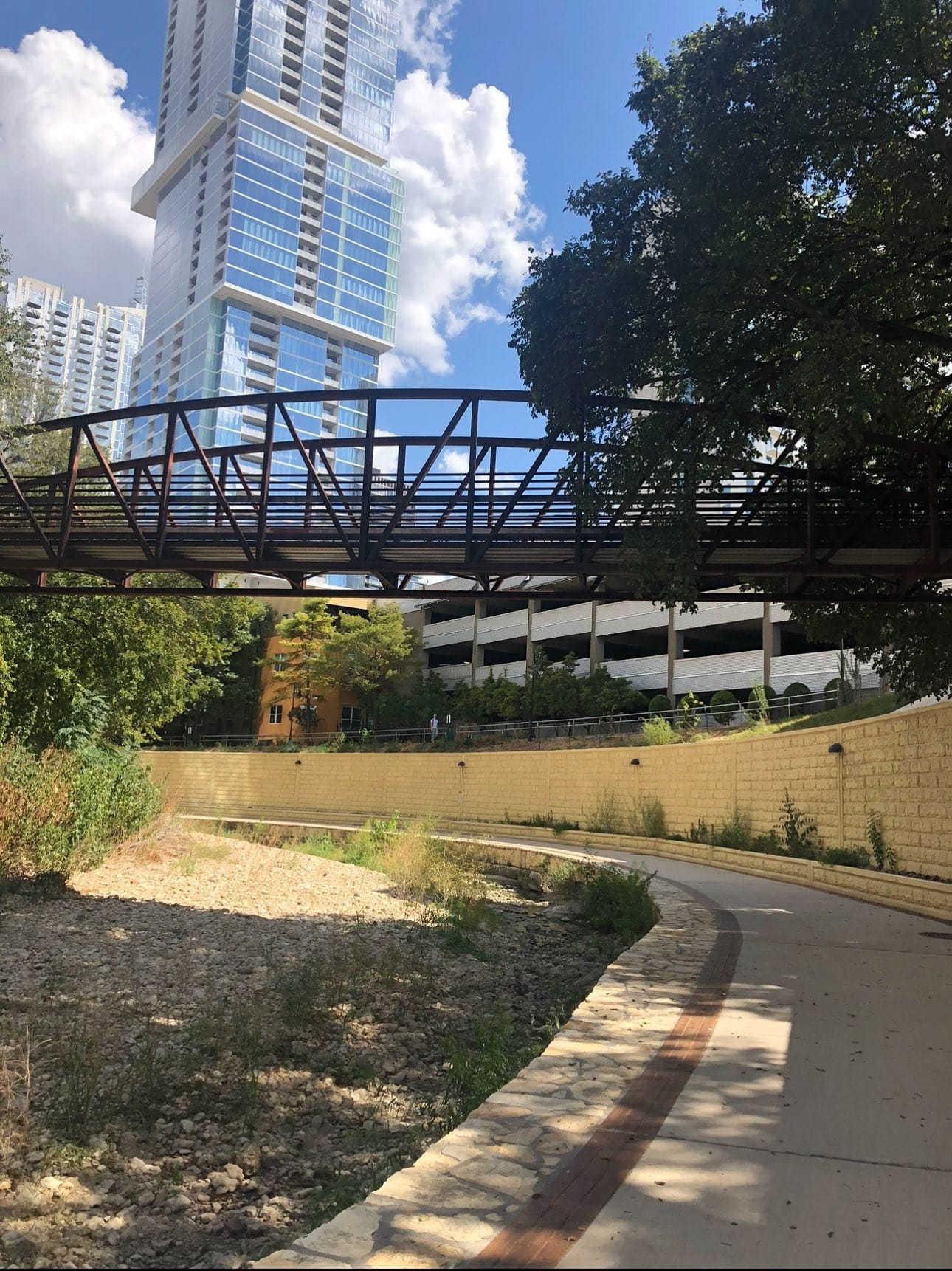
Present at City Hall that day were dozens of people who had worked with Riley in or around City Hall in service of a shared vision of a greener and more welcoming city. But there were also plenty who weren’t urbanist diehards.
Sitting in the front row as he addressed the dais were two of his former frequent foes in politics, Kathie Tovo and Laura Morrison.
“They have good hearts,” he said. “They're very committed to civic service. Especially at this time in my life, I don't want to have any kind of animosity towards anyone. I'm not a conflict-oriented person. I try to be friendly.”





